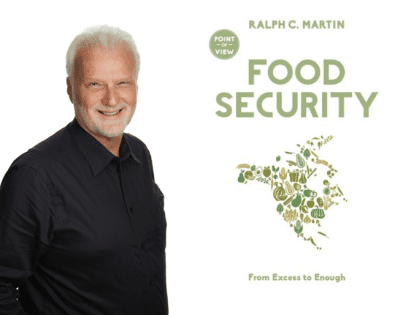by Ralph C. Martin
When crumbs of soil from prime farmland sift through the fingers of my right hand, I conclude that it should be used to grow food crops for human consumption, while maintaining or improving soil health. Obviously, prime farmland must not be paved over.
When more prime farmland soil trickles a bit faster through the 4.5 digits (I lost half of one on the farm) of my left hand, I ponder the best way to maintain or improve the health of that soil. My research informs me that forages (clover, alfalfa, timothy etc.) are required in rotation or in conjunction with row crops. In addition, animal manure, other organic amendments and crop residues can be applied to improve soil health.
Livestock play an important role, in particular, ruminants which convert soil-restoring forages to meat and milk. Livestock also provide the manure mentioned above. In addition, within a food system, livestock can consume and convert human inedible materials such as i) food processing by-products, ii) otherwise wasted food, iii) food crops which inadvertently do not meet specifications for human consumption and iv) crop residues. Clearly there is an ecological role for livestock.
Today, in a world of 1.4 billion cattle, 0.9 billion pigs and 24 billion chickens, more grain crops for livestock feed are required as well as the concomitant land to grow them. Furthermore, to maximize litres of milk per cow or kilograms of animal gain per day, human edible food often enhances livestock feed rations. Of all the world’s crops, only 55 percent of crop calories go directly toward people. The rest are allocated to biofuels or animal feed. Unfortunately, global methane emissions from livestock are 131.7 Tg methane per year, about one-third of global anthropogenic methane emissions.
Our ancestors practiced agriculture with due respect for the ecological role of livestock. The problem now is that with efforts to increase demand for animal protein, the livestock tail is wagging the entire food system.
Since WWII, when 20 million deaths from starvation exceeded those from direct military conflict, agricultural leaders have declared, “we must feed the world.” We responded on our home farm in the 1960s by turning the whole farm into one corn field as did others across Ontario. Now it’s time to rethink the dedication of over 2 million Ontario prime farmland acres per year for number 2, yellow dent corn, grown mostly for feed and fuel.
I understand the sunk costs (financial, cultural, emotional) of the current livestock system in which I grew up. Nevertheless, Dr. William Rees of UBC, who developed the ecological footprint analysis, stated in his recent paper The Human Ecology of Overshoot, “We are consuming and polluting the biophysical basis of our own existence. … The global economy will inevitably contract and humanity will suffer a major population ‘correction’ in this century.” Turning away from such warnings propels ecological systems further into overshoot. Governments must develop policies to help livestock farmers break free from sunk costs which prevent them from switching to human edible crop production. To feed the world and avoid overshoot, we need more human edible food crops and less feed.
Currently, more than 40% of prime farmland in Ontario which is dedicated to grow feed crops for livestock could be used instead to grow food crops for human consumption. In this scenario, there would still be sufficient animal protein for an adequate diet, according to the Canada Food Guide.
Many cultures have lived well for centuries with much less animal protein per person than consumed now in North America and Europe. It is becoming increasingly evident that we endanger our capacity to feed the world by over-assigning feed crops to prime farmland. The priority for this heritage is to grow crops for human edible food, while maintaining or improving soil health and overall ecological integrity.
Ralph C. Martin, Ph.D.,Professor (retired), University of Guelph. Information on book “Food Security: From Excess to Enough” at www.ralphmartin.ca.







Thank you.
May our neighbourhoods read you and hear you.
here’s a novel idea: eat field Corn and Soy beans as human food rather than shoving them through industry or livestock.